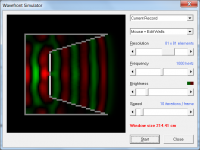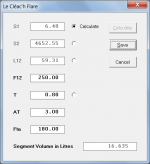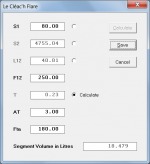Is there any way to speed up the slider response, or am I missing something?
Hi Oliver,
Have you tried clicking on the relevant capacitance slider so that it gains the focus, and then keying in the desired approximate value (say 650uF) and pressing Enter? This will get you in the "ball park" - you can then fine-tune as necessary by adjusting the slider normally.
Kind regards,
David
Didn't know that, very good!
Thanks!
Thanks!
Hi Oliver,
Have you tried clicking on the relevant capacitance slider so that it gains the focus, and then keying in the desired approximate value (say 650uF) and pressing Enter? This will get you in the "ball park" - you can then fine-tune as necessary by adjusting the slider normally.
Kind regards,
David
Didn't know that, very good!
Thanks!
Hi Bart,
It's all in the Filter Wizard section of the Hornresp Help file
"To directly set a slider control to a specified value, key in the value and then press Enter while the control has the focus."
Kind regards,
David
Hi David,
Great work, just downloaded V3230-130731. I'll have to find the time to try all the new wrinkles you've come up with. At the moment Internet Explorer does not want to play nice in the Forum, just by luck I got here. Hopefully, this will be better soon.
Best Regards,
Great work, just downloaded V3230-130731. I'll have to find the time to try all the new wrinkles you've come up with. At the moment Internet Explorer does not want to play nice in the Forum, just by luck I got here. Hopefully, this will be better soon.
Best Regards,
Last edited:
At the moment Internet Explorer does not want to play nice in the Forum, just by luck I got here. Hopefully, this will be better soon.
Best Regards,
It's not just IE, I had "Page not found" errors with Firefox and Chrome this morning. I was just about to post under forum problems but then it started working again.
Using hornresp to calculate exit angle of a driver: Jean Michel on LeCleac'h horns - Page 148 - diyAudio
It would be nice to be able to see exit angle of a horn. Measuring the length , entry and exit diameters of a driver throat gives you the exit angle. Using exponential will do for most drivers I guess.
It would be nice to be able to see exit angle of a horn. Measuring the length , entry and exit diameters of a driver throat gives you the exit angle. Using exponential will do for most drivers I guess.
It would be nice to be able to see exit angle of a horn.
Hi Mårten,
Not sure that I understand
In Hornresp the horn throat entry half-angle is given by AT, and the horn mouth flare tangent angle by Fta.
To exactly match a compression driver having an included exit angle of 6 degrees, the horn should therefore have an AT value of 3 degrees.
Assuming we want a fully-formed 180 degree mouth Le Cléac'h horn with a cutoff frequency of 250 hertz and a T value of 0.8, to exactly match a compression driver having an exit angle of 6 degrees, the Horn Segment Wizard can be used to find the required S1, S2 and L12 values - see attachment.
Kind regards,
David
Attachments
I'll have to find the time to try all the new wrinkles you've come up with.
Thanks Oliver.
Could you please let me know if you find any bugs, or if there is anything that doesn't make sense.
Kind regards,
David
Assuming we want a fully-formed 180 degree mouth Le Cléac'h horn with a cutoff frequency of 250 hertz and a T value of 0.8, to exactly match a compression driver having an exit angle of 6 degrees, the Horn Segment Wizard can be used to find the required S1, S2 and L12 values.
I realised after posting the above that I had probably selected the wrong Horn Segment Wizard option. The input parameters are more likely to be S1, F12, AT and Fta, rather than F12, T, AT and Fta - see new attachment. Note that if S1 is specified then the value of T is fixed. A transition piece could of course being included between the driver and the horn to give a greater degree of freedom in the dimensions.
Kind regards,
David
Attachments
Hi Mårten,
Not sure that I understand.
It was late when I wrote the post
When you want to find out the exit angle of a driver it would be practical to measure the dimensions of the throat, enter this in hornresp and get the exit angle. The only thing that is missing is the exit angle of a horn segment.
The only thing that is missing is the exit angle of a horn segment.
Hi Mårten,
The exit angle at the mouth of a horn segment is given by Fta. For all flare contours apart from exponential (Exp) and hyperbolic-exponential (Hyp) this information is shown either on the main input parameters screen or in the horn segment wizard. For Exp and Hyp segments, export the horn data from the schematic diagram window. The exit half-angle is the 'Angle' value at the full length of the horn, as shown in the data listing.
Kind regards,
David
If you ever are going to change the Schematic Diagram, please consider adding this feature.
Hi Mårten,
To calculate the driver exit angle, it is necessary to know the length of the air passage, its expansion profile, and the diameters at both ends. Can this information be obtained with a sufficient degree of accuracy without requiring the driver to be disassembled? It appears that you are assuming an exponential expansion rate, but is this always so?
How much would the proposed feature really be used? It seems to me that it is likely to have a rather limited application, in which case exporting the schematic diagram data (only required for an exponential flare) would probably be sufficient.
If you would like to do the calculation yourself, for an exponential flare the exit angle is given by 2 * Atan(D2 * Ln(D2 / D1) / (2 * L12)) where D1 = entry diamenter, D2 = exit diameter and L12 = air passage length.
For example, if:
D1 = 20mm
D2 = 25.4mm
L12 (Exp) = 50mm
then the exit angle = 6.95 degrees.
Kind regards,
David
- Home
- Loudspeakers
- Subwoofers
- Hornresp


